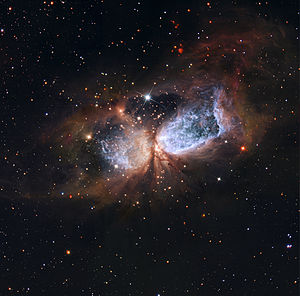Nh2-106
| H-II area | |
|---|---|
| Nh2-106 | |

|
|
| Superimposed image of the Hubble Space Telescope and the Subaru Telescope from Sh2-106 | |
| Constellation | swan |
|
Position equinox : J2000.0 |
|
| Right ascension | 20h 27m 27.1s |
| declination | + 37 ° 22 ′ 39 ″ |
| Further data | |
| distance |
2,000 ly |
| diameter | 2 × 0.5 ly |
| history | |
| discovery |
Rudolph Minkowski |
| Date of discovery |
1946 |
| Catalog names | |
| S106, M 1-99 | |
| Aladin previewer | |
Sh2-106 , Sharpless 2-106 or S106 for short is a compact H-II area in the constellation Swan in the northern sky . The object is about 2000 light years away from the sun and has a diameter of max. 2 ly. A star that has just emerged with the designation S106 IR in the center, itself covered by dust, has caused the hourglass-shaped shape and the turbulence visible in it.
The bipolar nebula was discovered by Rudolph Minkowski in 1946 while searching the sky for planetary nebulae . Since S106 did not have the characteristic light spectrum, he listed it under peculiar objects . Stewart Sharpless discovered it independently in 1959 on photographic plates of the Palomar Observatory Sky Survey .
Web links
- astronews.com: Hubble observes cosmic angel December 16, 2011
- astronews.com: Picture of the day August 8, 2013
Individual evidence
- ↑ a b SIMBAD : SH 2-106 - HII (ionized) region
- ^ A b Gemini Observatory : The Many Colors of Star Birth , Image Release, 2010
- ↑ Klaus W. Hodapp, Nicola Schneider: S106 , 2008hsf1.book ... 90H